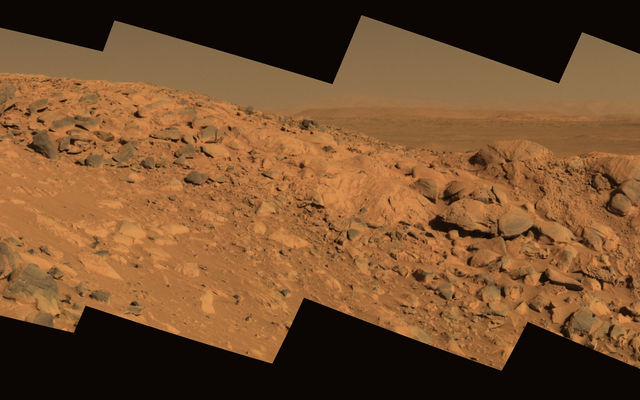This month it’s a special Monday morning edition of Space News Update, chock full of Martian goodies and Lunar chills. So let’s dive in!.
Martian Atmosphere Was Lost to Space
Solar wind and radiation are responsible for stripping the Martian atmosphere, transforming Mars from a planet that could have supported life billions of years ago into a frigid desert world, according to new results from NASA’s MAVEN spacecraft.
“We’ve determined that most of the gas ever present in the Mars atmosphere has been lost to space,” said Bruce Jakosky, principal investigator for the Mars Atmosphere and Volatile Evolution Mission (MAVEN), University of Colorado in Boulder. The team made this determination from the latest results, which reveal that about 65 percent of the argon that was ever in the atmosphere has been lost to space. Jakosky is lead author of a paper on this research to be published in Science on Friday, March 31.
In 2015, MAVEN team members previously announced results that showed atmospheric gas is being lost to space today and described how atmosphere is stripped away. The present analysis uses measurements of today’s atmosphere for the first estimate of how much gas was lost through time.
Liquid water, essential for life, is not stable on Mars’ surface today because the atmosphere is too cold and thin to support it. However, evidence such as features resembling dry riverbeds and minerals that only form in the presence of liquid water indicates the ancient Martian climate was much different – warm enough for water to flow on the surface for extended periods.
“This discovery is a significant step toward unraveling the mystery of Mars’ past environments,“ said Elsayed Talaat, MAVEN Program Scientist, at NASA Headquarters in Washington. “In a broader context, this information teaches us about the processes that can change a planet’s habitability over time.”

The early Sun had far more intense ultraviolet radiation and solar wind, so atmospheric loss by these processes was likely much greater in Mars’ history. According to the team, these processes may have been the dominant ones controlling the planet’s climate and habitability. It’s possible microbial life could have existed at the surface early in Mars’ history. As the planet cooled off and dried up, any life could have been driven underground or forced into rare surface oases.
Jakosky and his team got the new result by measuring the atmospheric abundance of two different isotopes of argon gas. Isotopes are atoms of the same element with different masses. Since the lighter of the two isotopes escapes to space more readily, it will leave the gas remaining behind enriched in the heavier isotope. The team used the relative abundance of the two isotopes measured in the upper atmosphere and at the surface to estimate the fraction of the atmospheric gas that has been lost to space.
As a “noble gas” argon cannot react chemically, so it cannot be sequestered in rocks; the only process that can remove noble gases into space is a physical process called “sputtering” by the solar wind. In sputtering, ions picked up by the solar wind can impact Mars at high speeds and physically knock atmospheric gas into space. The team tracked argon because it can be removed only by sputtering. Once they determined the amount of argon lost by sputtering, they could use this information to determine the sputtering loss of other atoms and molecules, including carbon dioxide.
CO2 is of interest because it is the major constituent of Mars’ atmosphere and because it’s an efficient greenhouse gas that can retain heat and warm the planet. “We determined that the majority of the planet’s CO2 was also lost to space by sputtering,” said Jakosky. “There are other processes that can remove CO2, so this gives the minimum amount of CO2 that’s been lost to space.”
The team made its estimate using data from the Martian upper atmosphere, which was collected by MAVEN’s Neutral Gas and Ion Mass Spectrometer (NGIMS). This analysis included measurements from the Martian surface made by NASA’s Sample Analysis at Mars (SAM) instrument on board the Curiosity rover.
“The combined measurements enable a better determination of how much Martian argon has been lost to space over billions of years,” said Paul Mahaffy of NASA’s Goddard Space Flight Center in Greenbelt, Maryland. “Using measurements from both platforms points to the value of having multiple missions that make complementary measurements.” Mahaffy, a co-author of the paper, is principal investigator on the SAM instrument and lead on the NGIMS instrument, both of which were developed at NASA Goddard.
NASA, ESA Rover Missions Narrow Landing Site Selections
Both NASA and ESA have been very busy; whittling down the possibilities for potential landing site for the next generation of Mars rovers. At the third landing site workshop for the Mars 2020 rover mission, a team of scientists narrowed down the list of potential places where NASA’s Mars 2020 rover may land. Three sites were selected to continue as landing site candidates: Columbia Hills, Jezero Crater, NE Syrtis.
The first site is where mineral springs once burbled up from the rocks of Columbia Hills. The discovery that hot springs flowed here was a major achievement of the Mars Exploration Rover, Spirit. The rover’s discovery was an especially welcome surprise because Spirit had not found signs of water anywhere else in the 160-kilometer wide Gusev Crater. After the rover stopped working in 2010, studies of its older data records showed evidence that past floods that may have formed a shallow lake in Gusev.

Credit:NASA
Jezero Crater tells a story of the on-again, off-again nature of the wet past of Mars. Water filled and drained away from the crater on at least two occasions. More than 3.5 billion years ago, river channels spilled over the crater wall and created a lake. Scientists see evidence that water carried clay minerals from the surrounding area into the crater after the lake dried up. Conceivably, microbial life could have lived in Jezero during one or more of these wet times. If so, signs of their remains might be found in lakebed sediments.

Credit: NASA
Volcanic activity once warmed NE Syrtis. Underground heat sources made hot springs flow and surface ice melt. Microbes could have flourished here in liquid water that was in contact with minerals. The layered terrain of NE Syrtis holds a rich record of the interactions that occurred between water and minerals over successive periods of early Mars history.

Credit: NASA
Essentially, NASA is looking for a site where water was once abundant. Part of the selection process is considering whether the area shows signs in the rock record that it once had the right environmental conditions to support past microbial life. Does the area have a variety of rocks and “soils” (regolith), including those from an ancient time when Mars could have supported life? Did different geologic and environmental processes, including interactions with water, alter these rocks through time? Are the rock types at the site able to preserve physical, chemical, mineral, or molecular signs of past life? Is the potential high enough for scientists to make fundamental discoveries with the samples cached by the rover, if potentially returned to Earth someday?
Meanwhile, ESA has in the last week narrowed down its choices of landing sites from three to two, sadly my department’s choice wasn’t one of them. These are located close to the equator.
“The present-day surface of Mars is a hostile place for living organisms, but primitive life may have gained a foothold when the climate was warmer and wetter, between 3.5 billion and 4 billion years ago,” says Jorge Vago, ESA’s ExoMars project scientist. “Therefore, our landing site should be in an area with ancient rocks where liquid water was once abundant. Our initial assessment clearly identified four landing sites that are best suited to the mission’s scientific goals.”
Two ancient sites on Mars that hosted an abundance of water in the planet’s early history have been recommended as the final candidates for the landing site of the 2020 ExoMars rover and surface science platform: Oxia Planum and Mawrth Vallis.

Oxia Planum Credit: ESA
A primary technical constraint is that the landing site be at a suitably low level, so that there is sufficient atmosphere to help slow the landing module’s parachute descent. Then, the 120 x 19 km landing ellipse should not contain features that could endanger the landing, the deployment of the surface platform ramps for the rover to exit, and driving of the rover. This means scrutinising the region for steep slopes, loose material and large rocks. Oxia Planum was selected in 2015 for further detailed evaluation. Although not yet complete, the investigation so far indicates that the region would meet the various constraints. In addition, one other site had to be chosen from Aram Dorsum and Mawrth Vallis, a place I’m all too familiar with having spent hours mapping it.

Mawrth Vallis :Credit ESA
After a two-day meeting with experts from the Mars science community, industry, and ExoMars project, during which the scientific merits of the three sites were presented alongside the preliminary compliance status with the engineering constraints, it was concluded that Mawrth Vallis will be the second site to be evaluated in more detail. Around a year before launch, the final decision will be taken on which site will become the ExoMars 2020 landing target. All of the sites lie just north of the equator, in a region with many channels cutting through from the southern highlands to the northern lowlands. As such, they preserve a rich record of geological history from the planet’s wetter past billions of years ago, and are prime targets for missions like ExoMars that are searching for signatures of past life on Mars.
Oxia Planum lies at a boundary where many channels emptied into the vast lowland plains and exhibits layers of clay-rich minerals that were formed in wet conditions some 3.9 billion years ago. Observations from orbit show that the minerals in Oxia Planum are representative of those found in a wide area around this region, and so would provide insight into the conditions experienced at a global scale during this epoch of martian history.
Mawrth Vallis is a large outflow channel a few hundred kilometres away from Oxia Planum. The proposed landing ellipse is just to the south of the channel. The entire region exhibits extensively layered, clay-rich sedimentary deposits, and a diversity of minerals that suggests a sustained presence of water over a period of several hundred million years, perhaps including localised ponds. In addition, light-toned fractures containing ‘veins’ of water-altered minerals point to interactions between rocks and liquid in subsurface aquifers, and possible hydrothermal activity that may have been beneficial to any ancient life forms. Mawrth Vallis offers a window into a large period of martian history that could probe the early evolution of the planet’s environment over time.
ENDURING THE LUNAR NIGHT
Designers of future Moon missions and bases have to contend with a chilling challenge: how might their creations endure the fortnight-long lunar night? ESA has arrived at a low-cost way of surviving. During prolonged night, when the surface is lit only by blue Earthlight, temperatures dip below –170ºC. Some locations at higher latitudes have shorter nights, though others have much longer or even permanent darkness. Numerous robotic missions have perished during this prolonged cold. Russia’s Lunokhod-2 rover, for instance, failed to make it through the night in May 1973, its radioactive heater having gradually run down after four months of exploring. The Apollo manned missions stayed on the surface only a few days at a time, and all during the early lunar morning. But future lunar settlers will have to live in the night as well as the day, bearing in mind that vital solar energy and heat would be unavailable during the 14 days of darkness.
“Up until now, radioactive heat and power sources have been the preferred solution for lunar habitats,” explains ESA’s Moritz Fontaine. “But these would multiply the cost and complexity of any expedition.

Credit: ESA
“So we’re exploring a more sustainable solution, using the capacity of moondust to absorb and store energy when hit by sunlight, then releasing this energy during the lunar night.”
The basic concept involves multiple mirrors to channel sunlight into processed lunar regolith, into which a heat engine would be placed. Driven by the temperature difference, this heat engine would be kept running directly by the heat of the Sun during the day – illuminated surface temperatures rise well above 100ºC at the equator – while simultaneously storing excess heat in the soil.Once night falls, the heat engine would be kept running in turn by the gradual release of the energy from the heated soil.
“The principle has been worked out in detail,” adds Moritz. “The next step, being undertaken through ESA’s General Studies Programme, is to perform numerical and simulation studies to put values on the heat storage and electricity provision the system would enable. “The results should then allow the construction of a small demonstrator to test the concept in practice.”
If successful, this technology would directly extend the longevity of unmanned lunar missions, as well as significantly increasing the viability of future human habitation. All in all, this is an exciting time for space science, and space exploration. Leave your own thoughts and questions in the comments, and we’ll see you next month!

